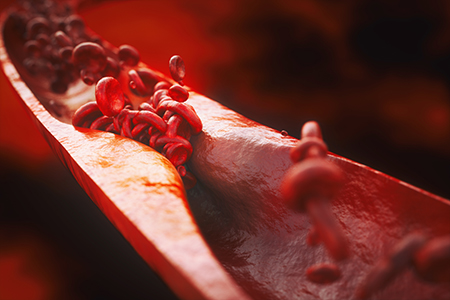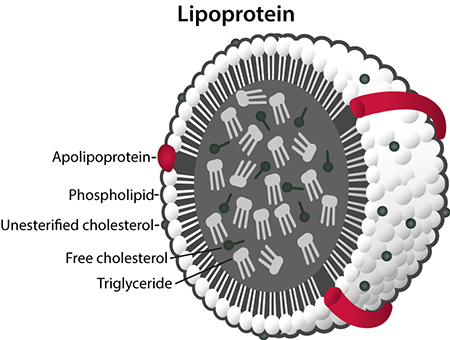 Cardiovascular disease (CVD) is a term that encompasses multiple heart and blood-vessel-related maladies. The CDC reports that it is the leading cause of death amongst both men and women in the US each year, with roughly 800,000 deaths estimated by the American Heart Association in 2018.
Cardiovascular disease (CVD) is a term that encompasses multiple heart and blood-vessel-related maladies. The CDC reports that it is the leading cause of death amongst both men and women in the US each year, with roughly 800,000 deaths estimated by the American Heart Association in 2018.
Review of lipoproteins
Lipoproteins are lipid-protein complexes that contain a hydrophilic outer shell and an inner hydrophobic core. Both low-density lipoproteins (LDL) and high-density lipoproteins (HDL) are measures of cholesterol in the blood because these proteins transport fat, triglycerides, and cholesterol through the body.These complex molecules have a "shell" composed of cholesterol, phospholipids, and apolipoproteins, and a core with the transport material: cholesterol esters and triglycerides (see Figure 1).

Figure 1: Source Mabtech
What are Apolipoproteins?
Apolipoproteins are protein-lipid complexes that bind oil-soluble substances such as fat and cholesterol. Due to their amphipathic structure they can encapsulate fat-soluble vitamins and lipids and transport them through water-based fluids like the blood, lymph, and cerebral spinal fluid. They are integral parts of the outer shell of lipoproteins.They have four main functions:
Apolipoprotein E in CVD
While this Insight will be discussing the role of ApoE in CVD, this protein also plays an important role in Alzheimer's disease as it is the principal transporter of cholesterol in the brain.The gene encoding ApoE is polymorphic — meaning it has multiple alleles — which translates to three protein isoforms: E2, E3, and E4. These isoforms are present in drastically different percentages in the human body, and all have different functions.
- ApoE2 — Allelic frequency of 5 — 10%3 — Lipoproteins with ApoE2 on their surface exist in serum longer due to the poor binding affinity between ApoE2 and lipoprotein cell surface receptors, thereby increasing risk of atheorsclerosis4.
- ApoE3 — Allelic frequency of 65 — 70%3 — ApoE3 is the most prevalent and most neutral form of this protein — it is neither pro- nor anti-atherogenic.
- ApoE4 — Allelic frequency of 15 — 20%3 — has been implicated in atherosclerosis and Alzheimer's disease, and contributes to increased serum cholesterol levels and the development of CVD5,6.
Apolipoprotein B in CVD
Of the two forms of Apolipoprotein B — Apo B-48 and Apo B-100 — Apo B‐100 is more relevant in CVD studies. This particle is synthesized in the liver and is present in one copy on the surface of LDL, IDL, VLDL, and Lp(a) particles.Apo B-100 is essential for binding events between LDL receptors and LDL particles, thereby enabling the internalization of LDL into cells and uptake of cholesterol7,8. Since Apo B-100 is present in one copy per lipoprotein it is, therefore, a direct measure of the number of pro-atherogenic lipoproteins in the blood, and may present a better metric for measuring cholesterol levels9-11.
Animal Models of Cardiovascular Disease
Many research needs can be addressed by animal models that either over- or under-express apolipoproteins. These are some animal models that have human versions of the ApoE and Apo B proteins that can be used to study cardiovascular disease:| Mouse Model | Taconic Model # | Roles in Cardiovascular Disease |
| Apoe mouse | APOE | Lacks the ApoE protein, results in five times normal serum plasma cholesterol and spontaneous atherosclerotic lesions |
| APOE2 mouse | 1547 | Expresses human ApoE2, develops hyperlipoproteinemia with elevated plasma cholesterol and triglyceride levels, decreased clearance of VLDL particles, and spontaneous atherosclerotic plaques |
| APOE3 mouse | 1548 | Expresses human ApoE3, exhibits an increased risk of atherosclerosis and hypercholesterolemia |
| APOE4 mouse | 1549 | Expresses human ApoE4, exhibits an increased risk of atherosclerosis, and more severe symptoms than the Apo-E3 mouse |
| ApoB100 | 1004 | Expresses human Apo B-100, shows elevated serum levels of LDL cholesterol, develops atherosclerosis or a HF/HC diet |
| CETP-ApoB100 | 3716 | Expresses both human cholesteryl ester transfer protein and human Apolipoprotein B transgenes, exhibits human-like serum HDL/LDL distribution. Develops complex atherosclerotic lesions under a HF/HC diet |
















.jpg)

.jpg)
.jpg)
.jpg)
.jpg)





.jpg)


.jpg)
.jpg)




.jpg)




.jpg)

.jpg)



